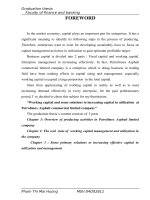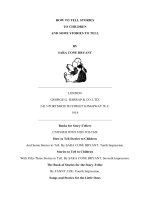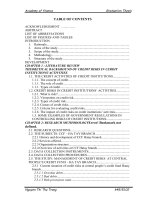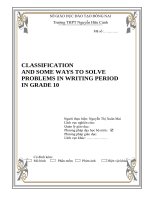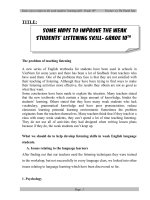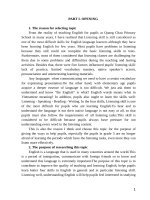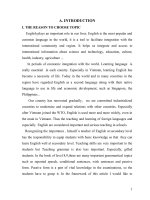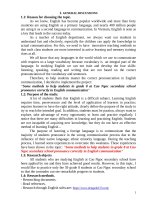skkn CLASSIFICATION AND SOME WAYS TO SOLVE PROBLEMS IN WRITING PERIOD IN GRADE 10
Bạn đang xem bản rút gọn của tài liệu. Xem và tải ngay bản đầy đủ của tài liệu tại đây (207.29 KB, 19 trang )
SỞ GIÁO DỤC ĐÀO TẠO ĐỒNG NAI
Trường THPT Nguyễn Hữu Cảnh
Mã số :…………
CLASSIFICATION
AND SOME WAYS TO SOLVE
PROBLEMS IN WRITING PERIOD
IN GRADE 10
Người thực hiện: Nguyễn Thị Xuân Mai
Lĩnh vực nghiên cứu:
Quản lý giáo dục:
Phương pháp dạy học bộ môn:
Phương pháp giáo dục:
Lĩnh vực khác: ………………
Có đính kèm:
Mô hình
Phần mềm
Phim ảnh
Hiện vật khác
Classification and some ways to solve problems in writing period in grade 10
CONTENTS
A. REASONS FOR CHOOSING THE RESEARCH
B. AIMS OF THE RESEARCH
C. SCOPE, OBJECT AND RESEARCHING METHOD
D. MAIN CONTENT
I. GENERAL INTRODUCTION
1. What makes writing so important?
2. Some difficulties of the teacher and the students
II. CLASSIFICATION AND SOME WAYS TO SOLVE PROBLEMS IN
WRITING IN GRADE 10
1. Classification of the writing section in grade 10
2. What do students need to do in order to write?
3. Writing as a process
4. The meanings of some writing activities
5. Some ways to solve problems in writing period in grade 10
6. Demonstration
E. RESULT AFTER APPLYING THE RESEARCH IN TEACHING
F. CONCLUSION
G. REFERENCE BOOKS
2
Classification and some ways to solve problems in writing period in grade 10
A. REASONS FOR CHOOSING THE RESEARCH
This is the seven year we are carrying out the reformation in teaching new
English textbook. Most of the teachers are used to this new English textbook and
try to find out good teaching methods as much as possible to apply in English
periods.
In Vietnam, secondary school students have to acquire four skills of English as
reading, speaking, listening and writing when they study English. Among them,
writing is considered the most difficult skill. Clearly, Vietnamese students are
often much anxious about writing and afraid of making errors in writing
classrooms. Nevertheless, they need to be encouraged to see it as a means of
learning, rather than demonstrating learning. In order to make writing skill more
effective, the teacher himself must find out the way of teaching suitable for his
students.
The Writing section may begin with a model, followed by activities that
guide students through the writing process such as model analysis, language work,
or guided writing, etc. In this part, students are required to produce various text
types such as personal and formal letters, narratives, chart, graph and table
description, and expository essays. The general and specific objectives are set
clearly in the books.
The role of writing skill in grade 10 mainly helps students get familiar with
style, some structures and learn how write letters, narrative, description, etc … If
the teacher wants the writing period to be more effective, he should not only
systemize the content but also prepare his lesson plans more carefully. Also, there
are a great number of problems in writing period, how can the teacher solve them?
I myself want to present the classification of the writing section and some
ways to solve problems in writing period in grade 10.
B. AIMS OF THE RESEARCH
- To introduce the classification of writing lessons in grade 10
- To show some ways to deal with problems that may arise
3
Classification and some ways to solve problems in writing period in grade 10
C. SCOPE, OBJECT AND RESEARCHING METHOD
- Scope: Researching in the process of teaching English at Nguyen Huu
Canh high school.
- Object: Being concerned with classification of writing section and some
ways of solving problems in writing period in grade 10.
- Researching method: Reading reference books, discussing with other
teachers, applying in teaching, observing and drawing out experiences.
D. CONTENT
I. GENERAL INTRODUCTION
1. What Makes Writing So Important?
• Writing is the primary basis upon which your work, your learning, and
your intellect will be judged in college, in the workplace, and in the community.
• Writing expresses who you are as a person.
• Writing is portable and permanent. It makes your thinking visible.
• Writing helps you move easily among facts, inferences, and opinions
without getting confused—and without confusing your reader.
• Writing promotes your ability to pose worthwhile questions.
• Writing fosters your ability to explain a complex position to readers, and to
yourself.
• Writing helps others give you feedback.
• Writing helps you refine your ideas when you give others feedback.
• Writing requires that you anticipate your readers’ needs. Your ability to do
so demonstrates your intellectual flexibility and maturity.
• Writing ideas down preserves them so that you can reflect upon them later.
• Writing out your ideas permits you to evaluate the adequacy of your
argument.
• Writing stimulates you to extend a line of thought beyond your first
impressions or gut responses.
• Writing helps you understand how truth is established in a given discipline.
4
Classification and some ways to solve problems in writing period in grade 10
• Writing equips you with the communication and thinking skills you need
to participate effectively in democracy.
• Writing is an essential job skill.
2. Some difficulties of the teacher and the students
a. To the teacher
- There are too many students in a class so it is very difficult for the teacher
to pay attention to all students in writing period.
- There are a large number of students with different levels.
- He is often anxious that he doesn’t have enough time to correct mistakes
for all students.
- The process of writing may last more than 45 minutes.
b. To the students
- They often fell bored in writing period.
- They do not have enough vocabulary and structures to express ideas.
- They have a tendency to use speaking English and translate Vietnamese
into English in writing.
- Their knowledge about society is limited.
- They sometimes misuse the purpose of different types of writing.
- They often express many ideas and information in the same sentence or
they write too long sentences.
- They do not have enough facts, information and knowledge about different
subjects, so they cannot write convincingly.
II. CLASSIFICATION AND SOME WAYS TO SOLVE PROBLEMS IN
WRITING PERIOD IN GRADE 10
1. Classification of the writing section in grade 10
a. What is teaching writing?
Good writing conveys a meaningful message and uses English well, but the
message is more important than correct presentation. If you can understand the
message or even part of it, your student has succeeded in communicating on paper
and should be praised for that. For many students, writing skills will not be used
5
Classification and some ways to solve problems in writing period in grade 10
much outside your class. This doesn’t mean that they shouldn’t be challenged to
write, but you should consider their needs and balance your class time
appropriately.
Two writing strategies you may want to use in your lessons are free writing
and revised writing. Free writing directs students to simply get their ideas onto
paper without worrying much about grammar, spelling, or other English
mechanics. In fact, the teacher can choose not to even look at free writing pieces.
To practice free writing, give students 5 minutes in class to write about a certain
topic, or ask them to write weekly in a journal. You can try a dialog journal where
students write a journal entry and then give the journal to a partner or the teacher,
who writes another entry in response. The journals may be exchanged during class,
but journal writing usually is done at home. The main characteristic of free writing
is that few (if any) errors are corrected by the teacher, which relieves students of
the pressure to perform and allows them to express themselves more freely.
Revised writing, also called extended or process writing, is a more formal
activity in which students must write a first draft, then revise and edit it to a final
polished version, and often the finished product is shared publicly. You may need
several class sessions to accomplish this. Begin with a pre-writing task such as free
writing, brainstorming, listing, discussion of a topic, making a timeline, or making
an outline. Pairs or small groups often work well for pre-writing tasks. Then give
the students clear instructions and ample time to write the assignment. In a class,
you can circulate from person to person asking, “Do you have any questions?”.
Many students will ask a question when approached but otherwise would not have
raised a hand to call your attention. Make yourself available during the writing
activity; don’t sit at a desk working on your next lesson plan. Once a rough draft is
completed, the students can hand in their papers for written comment, discuss them
with you face to face, or share them with a partner, all for the purpose of receiving
constructive feedback. Make sure ideas and content are addressed first; correcting
the English should be secondary. Finally, ask students to rewrite the piece. They
should use the feedback they received to revise and edit it into a piece they feel
6
Classification and some ways to solve problems in writing period in grade 10
good about. Such finished pieces are often shared with the class or posted publicly,
and depending on the assignment, you may even choose to “publish” everyone’s
writing into a class booklet.
Tactful correction of student’s writing is essential. Written correction is
potentially damaging to confidence because it’s very visible and permanent on the
page. Always make positive comments and respond to the content, not just the
language. Focus on helping the student clarify the meaning of the writing.
Especially at lower levels, choose selectively what to correct and what to ignore.
Spelling should be a low priority as long as words are recognizable. To reduce ink
on the page, don’t correct all errors or rewrite sentences for the student. Make a
mark where the error is and let the student figure out what’s wrong and how to fix
it. At higher levels you can tell students ahead of time exactly what kinds of errors
(verbs, punctuation, spelling, word choice) you will correct and ignore other errors.
If possible, in addition to any written feedback you provide, try to respond orally to
your student’s writing, making comments on the introduction, overall clarity,
organization, and any unnecessary information.
b. Classification
Below is the classification of writing section in grade 10. When classifying
and understanding their types and features clearly we can prepare lesson plans for
writing periods better.
Text types
Letters
Examples
- complain
Units
Unit 4
Features
- Language: formal
- filling in a form
Unit 2
- Logical ordering of ideas
- announcement
- confirmation
- invitation
- acceptance & refusal
- giving directions
Unit 14
Unit 6
Unit 10
Unit 11
Unit 8
- routines
- people’s background
- profile
- instructions
Unit 1
Unit 3
Unit 12
Unit 5
7
- Language: informal
Classification and some ways to solve problems in writing period in grade 10
- a film
Unit 13 Language:
friendly,
- a city
-
advantages
Unit 15
& Unit 7
descriptive
- Language: formal
Expository
disadvantages of mass
- generalization-to
(explaining)
media
- tables & charts
- Specific ordering of ideas or
Unit 9,
facts.
16
2. What do students need to do in order to write?
When you ask your students to write any topic you should certainly know
that they understand clearly the following problems:
know the aim – why they are writing
know the reader – who they are writing to
know the genre – what type of text they are writing
have enough time for:
thinking about the topic
brainstorming ideas
planning ahead carefully
drafting as many times as they can
Students have constant feedback from teacher as well as their partners
during the writing process.
3. Writing as a process
We can summarize the writing process as the chart below:
Getting
ideas
together
Being
motivated
planning to
write
Planning
8
Classification and some ways to solve problems in writing period in grade 10
Final
version
drafting
Revising
replanning
redrafting
4. The meanings of some writing activities
There are a large number of activities or tasks in writing period. All of these
aim to develop writing skill for students. Also, we easily recognize the logical
relation of these activities or tasks. In English textbook 10, each writing lesson
often consists of 3 or 4 tasks constructed as spiral type. If the lesson has 3 tasks,
first two tasks (if the lesson has four tasks, first three tasks) provide students with
genre, vocabulary, structures, etc. (prepare to write) and at the same time help them
use range of language features appropriately. After finishing these tasks, the
students have “a good source of information” and “coming up with ideas”
writing production (final task).
Understanding the aim, meaning of each activity, function and requirement
of each task is very important. It is not simple to finish those tasks but more
importantly how to organize the class: work individually, in pairs, in groups or
whole class? What is the process (how many steps)? How long do they write?
Feedback: from doing the tasks the students can draw the things preparing for
production.
Now look at some types of tasks in writing lesson class.
9
Classification and some ways to solve problems in writing period in grade 10
+ Copying: this is the task to consolidate students’ knowledge. One student
copies one sentence of the conversation or paragraph that they have just learnt and
then the next student writes down the next sentence. It is the chain dialogue. By
this way the students must understand what they write. Teacher should use this one
as Warm-up.
Example: In Unit 1: A day in the life of … to prepare for writing narrative
teacher can ask students to write a short conversation:
Student 1: What did Nam do yesterday afternoon?
Student 2: He went to the library.
Student 3: What book did he read?
Student 4: He read an English book.
Student 5: How long did he read?
………………..
Then teacher has students collect the answers to make a short paragraph.
“Nam went to the library yesterday afternoon, he went there to read an
English book, he read …”
After finishing this task the students define the kind of writing they are
going to write.
+ Constructing dialogue: there are 3 kinds of this in English textbook 10
- Students are given a writing sample. After reading it they use the suggestion to
finish the similar task. We can see this kind of task in Unit 1, Unit 3, Unit 6, Unit
8, Unit 9, Unit 14.
- Students are given jumbled sentences. They have to rearrange them to make a
good conversation. We can see this kind of task in Unit 11 (task 2).
- Students are given unfinished conversation and some disordered sentences. They
have to finish the conversation by filling the blanks to make good one from
disordered sentences or from the information they think suitable for each blank.
We can see this kind of task in Unit 2, Unit 4, Unit 10 (task 2), Unit 11 (task 1).
10
Classification and some ways to solve problems in writing period in grade 10
+ Expanding frames: students have to finish the writing based on the given
frame. This can be a letter, a biography, etc., related to the writing topic. We can
see this kind of task in Unit 10 (task 3), Unit 12.
+ Idea frames: Students are given a reading task and they have to answer
some questions about that. From answering those questions the students
themselves draw out important things to remember. Basing on the frame of
questions and the given reading task they write another similarly required one. We
can see this kind of task in Unit 5, Unit 13, Unit 14, Unit 15, Unit 16.
+ Parallel: Students are required to read a paragraph and then they write a
similar one but replace by new information. We can see this kind of task in Unit 3,
Unit 6, Unit 7, Unit 8.
5. Some ways to solve problems in writing period in grade 10
As I mentioned above there are many difficulties in writing period in grade
10, how can we solve them? In my opinion we should do as following:
a. To some objective problems:
The teacher divides the class into groups or pairs according to the aim of
lesson. While the students are working, teacher should walk around to give help if
necessary. Teacher can guide them to correct mistakes by themselves or help their
partners correct mistakes. It’s not necessary to carry out all the steps of teaching
writing in class if the lesson is too long. Some steps the teacher can ask the
students to do at home. For example: Teacher can ask students to prepare
vocabulary, structures, outline, writing topic at home. Students can draft their
writings at home and final production is continued in class.
Teacher should let students find out knowledge or social knowledge relating
to the lesson so that they can have necessary information they need in expressing
ideas. Teacher shouldn’t give all ideas for students.
Teacher should share or exchange his wonder or plan with his colleagues in
order to find out the effective solutions for difficulties.
Teacher should use suggestions to encourage students to overcome their
shortage of vocabulary, opinion, structures, …
11
Classification and some ways to solve problems in writing period in grade 10
Teacher should explain, encourage that English is not only for tests or
examinations but also for the needs in daily life, it’s important for them to have
good English in international economic integration period.
b. To some problems from students:
The pre-writing stage is a very important step for students to consolidate
vocabulary, structures and it helps them create ideas for writing. In this stage,
teacher should provide essential structures and vocabulary relating to topic for
students to express opinions.
Teacher should explain to students how to start writing carefully, guide them
through simple task first, which is suitable for their ability.
Teacher should use suggestion not only by language but also by pictures,
visual aids and writing samples.
Teacher should help students express their ideas by English to diminish the
influence of mother tongue in writing process.
Teacher should help students get familiar with writing process by using
different stages to suggest practical writings to them.
Teacher should help students find out exact reader and aim for every writing
task. If the aim for each task in textbook is not clear enough, the teacher should
explain more clearly by different ways (the explanation should promote creative
thinking of students) so that they can find out right reader and aim for the whole
writing.
Teacher should help students simplify the connection ideas to reduce
sentences or paragraph not clear or coherent.
Teacher should use practical information or knowledge close to daily
activities.
Teacher should organize writing activities such as: games, designing posters,
creative writing, poems, … to make the climate of the class more exciting.
Teacher should not give students compulsory homework because it makes
students study passively. Teacher should encourage students’ reading at home
instead of writing task.
12
Classification and some ways to solve problems in writing period in grade 10
6. Demonstration:
To make a teaching period really effective, it is very important for a teacher
to define specific duties and find out emphasis on knowledge for students in a
period in common and especially in writing period.
Let’s look at specific duties and objectives to be achieved of some writing
lessons in English textbook 10.
Writing lesson of Unit 1: Writing a narrative
Task 1:
Students have to do 2 duties at the same time:
- find all the verbs used in the past simple: stared, was, arrived, got on, …
- find connectors: on that day, at first, then, …
Teacher should ask students to scan the passage to finish the task.
Task 2:
In this task teacher should remind students to finish three parts:
- Events (these are the activities happening before the climax): got on plane, plane
took off, …
- Climax (this is the most noticeable part): we thought we had only minutes to live
- Conclusion (this part often lies at the end of the story and states the narrator’s
impression or feeling): pilot announced that everything was right, we landed
safely.
Task 3:
Before doing this task teacher should remind students how to conjugate the verbs
to make them suitable for story time.
Writing lesson of Unit 7: Writing about advantages and disadvantages of the
mass media
Task 1:
Teacher lets students read about the advantages and disadvantages of television
and underline some useful structures used in the table such as:
+ help us to learn, encourage us to buy help / encourage S.O to do sth
+ make things memorable, make us aware of, make us passive, make people
13
Classification and some ways to solve problems in writing period in grade 10
violent make S.O / sth + adjective
Teacher asks students to retell the advantages and disadvantages of television,
using the above structures.
Task 2:
Students can use Task 1 to discuss the advantages and disadvantages of the mass
media and write them down in the columns. Teacher should remind students every
type of the mass media has two sides: good one and bad one.
Suggested answer
Radio
Advantages
- Make people happy / life easier
Disadvantages
- Waste time
- Relax
- Make people passive
- Broaden knowledge and
understanding
Newspapers
The Internet
- Share opinions / experiences
- Make people happy / life easier
- Harm people eyes: be short-
- Get information on many
sighted
fields: culture, art, business
- Cost time and money
- Relax and entertain
- Make people happy / life easier
- Make people passive
- Harm people eyes: be short-
- Provide quick and daily access
sighted
to information and entertainment
- Cost time and money
- Get information on many
- Make people passive
fields: culture, art, business
- Affect people’s life
Task 3:
Students write a paragraph about the advantages and disadvantages of one of the
mass media discussed in Task 2.
Before students write teacher should give them an outline to help them write more
easily. Students can write in deductive method or inductive one.
1. Form
Introduction:
General
introduction
disadvantages
14
about
the
advantages
and
Classification and some ways to solve problems in writing period in grade 10
Body:
- topic sentence:
- Advantages
- supporting sentences:
+ Firstly / First of all, Secondly, …., Finally / Lastly
+ Another (dis)advantage is that ……
+ In addition, / Also, / And, / Moreover, / Besides, /
- Disadvantages
Furthermore, …
Introducing contrast: However, / On the other hand, /
… But, ….
Conclusion: conclusion about the advantages and disadvantages
In conclusion, / In short / On balance, I’d like to say that …
2. Useful language:
- Tense: simple present tense
- Expressions: - help / encourage us to + V
- enlarge / broaden knowledge
- make S.O / sth + adjective
Writing lesson of Unit 13: Describing a film
Task 1:
After reading the description of the film Titanic students answer the questions
about it. From answering these questions teacher should help them draw out the
structures to understand how to describe a film.
- The name of the film
+ The name of the film is …...
- Kind of the film
+ It’s a romantic / detective / horror film …
- The content of the film
+ It’s about …
+ The film is a story of …
+ The film tells us a story about …
- The setting of the film
15
Classification and some ways to solve problems in writing period in grade 10
+ The film is set in … (a small village in 1998)
+ The story takes place in …
- what the film is based on
+ The film is based on a true story in 1990.
+ The film is based on a novel of Nam Cao.
+ The film is made based on the event of …
- The main characters
+ The two main characters of the film are Leonardo and Vivien.
+ The main actor / actress of the film is …
- Your knowledge about the characters
+ Leonardo is very famous actor.
+ Nicole Kidman has won some Oscar prizes.
- The ending of the film
+ The film has a sad / happy / tragic ending.
- Your feeling of the film
+ I think the film is very interesting / boring / frightening / …
- The lesson you can learn from the film
+ The film makes me realize that I must appreciate the life and what we have.
+ The film strengthens my belief in human ability.
+ Thanks to the film, I realize that if we are strongly determined, we can make our
wishes come true despite the difficulties in life.
Task 2:
In this task students are required to write about a film they have seen. They can use
the description of Titanic and the questions in Task 1 as suggestions.
Before doing this task teacher should help students draw out the outline of
describing a film.
Thanks to this outline it’s easy for students to do this task.
E. RESULT AFTER APPLYING THE RESEARCH IN TEACHING
From some ways to solve problems in writing period in grade 10 and the ways of
teaching, the table below expresses clearly the differences in the students’ attitude
16
Classification and some ways to solve problems in writing period in grade 10
towards the way to participate in the lessons. Before applying the research in
teaching not all students in classes take part in the lessons actively. After applying
it, students join in the lessons more actively. The climate of classes is more
exciting.
Class
Number of Before applying the research in After applying the research in
10A5
10A9
students
44
teaching
teaching
about 52% of students take part about 83% of students take part
45
actively in the lessons
actively in the lessons
about 59% of students take part about 93% of students take part
actively in the lessons
actively in the lessons
F. CONCLUSION:
To make my writing period in grade 10 more effective I have already tried
to solve problems happening in each period.
Despite my trying a lot, the content of this research is only my personal
experience of teaching. Therefore, there must be some mistakes that I myself still
cannot find out. I hope I will get suggestions from the readers as many as possible.
I hope that the study will make contribution to the better situation of
teaching and learning English.
Thank you very much
Bien Hoa city, May 22nd 2012
Composer
Nguyen Thi Xuan Mai
REFERENCE BOOKS
1. Practical handbook of language teaching (David Cross)
17
Classification and some ways to solve problems in writing period in grade 10
2. A course in language teaching - Practical and Theory (Penny Ur) Cambrige
university press
3. Giáo trình giáo học pháp (Tổ ngoại ngữ –Khoa ngôn ngữ và văn hóa Anh - Mĩ Úc – Trường đại học quốc gia Hà Nội)
4. Phương pháp dạy tiếng Anh Trung học phổ thông (Nguyễn Hạnh Dung)
5. Marquette University’s website
6. Colorado State University’s website
SỞ GD & ĐT ĐỒNG NAI
Trường THPT Nguyễn Hữu Cảnh
CỘNG HOÀ XÃ HỘI CHỦ NGHĨA VIỆT NAM
Độc lập – Tự do – Hạnh phúc
18
Classification and some ways to solve problems in writing period in grade 10
Biên Hoà, ngày 22 tháng 5 năm 2013
PHIẾU NHẬN XÉT, ĐÁNH GIÁ SÁNG KIẾN KINH NGHIỆM
Năm học: 2011 - 2012
Tên sáng kiến kinh nghiệm:
Classification and some ways to solve problems in writing period in grade 10
Họ và tên tác giả: Nguyễn Thị Xuân Mai
Đơn vị (tổ): Tổ Ngoại Ngữ
Lĩnh vực:
Quản lý giáo dục
Phương pháp dạy học bộ môn
Phương pháp giáo dục
Lĩnh vực khác ………………………….
1. Tính mới:
- Có giải pháp hoàn toàn mới.
- Có giải pháp cải tiến đổi mới từ giải pháp đã có.
2. Hiệu quả:
- Hoàn toàn mới và đã triển khai áp dụng trong toàn ngành có hiệu quả cao.
- Có tính cải tiến hoặc đổi mới từ những giải pháp đã có và đã triển khai áp dụng
trong toàn ngành có hiệu quả cao.
- Hoàn toàn mới và đã triển khai áp dụng tại đơn vị có hiệu quả cao.
- Có tính cải tiến hoặc đổi mới và đã triển khai áp dụng tại đơn vị có hiệu quả.
3. Khả năng áp dụng:
- Cung cấp được các luận cứ khoa học cho việc hoạch định đường lối chính sách:
Tốt
Khá
Đạt
- Đưa ra các giải pháp khuyến nghị có khả năng ứng dụng thực tiễn, dễ thực hiện
và dễ đi vào cuộc sống:
Tốt
Khá
Đạt
- Đã được áp dụng vào thực tế đạt hiệu quả hoặc có khả năng áp dụng đạt hiệu quả
trong phạm rộng:
Tốt
Khá
Đạt
XÁC NHẬN CỦA TỔ CHUYÊN MÔN
Tổ trưởng
Lý Thị Thanh Tâm
HIỆU TRƯỞNG
Phan Quang Vinh
19
